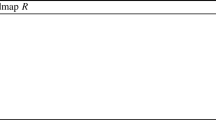Abstract
We describe a real-time system that supports design of optimal flight paths over terrains. These paths either maximize view coverage or minimize vehicle exposure to ground. A volume-rendered display of multi-viewpoint visibility and a haptic interface assists the user in selecting, assessing, and refining the computed flight path. We design a three-dimensional scalar field representing the visibility of a point above the terrain, describe an efficient algorithm to compute the visibility field, and develop visual and haptic schemes to interact with the visibility field. Given the origin and destination, the desired flight path is computed using an efficient simulation of an articulated rope under the influence of the visibility gradient. The simulation framework also accepts user input, via the haptic interface, thereby allowing manual refinement of the flight path.
Similar content being viewed by others
Explore related subjects
Discover the latest articles, news and stories from top researchers in related subjects.References
Avila, R.S., Sobierajski, L.M.: A haptic interaction method for volume visualization. In: Proceedings of IEEE Visualization, pp. 197–204. IEEE Press, Washington, DC (1996)
Ben-Moshe, B., Carmi, P., Katz, M.J.: Approximating the visible region of a point on a terrain. In: Arge, L., Italiano, G.F., Sedgewick, R. (eds.) Proceedings of 6th Workshop on Algorithm Engineering and Experiments and the 1st Workshop on Analytic Algorithmics and Combinatorics (ALENEX-04), pp. 120–128. Springer, Berlin Heidelberg New York (2004)
Bittner, J., Wonka, P.: Visibility in computer graphics. J. Environ. Plann B Plann Des. 5(30), 729–756 (2003)
Bryson, S.: Virtual reality in scientific visualization. Commun. ACM 39(5), 62–71 (1996)
Cohen-Or, D., Chrysanthou, Y., Silva, C., Durand, F.: A survey of visibility for walkthrough applications. IEEE Trans. Visual. Comput. Graph. 9(3), 412–431 (2003)
Cole, R., Sharir, M.: Visibility problems for polyhedral terrains. J. Symb. Comput. 7(1), 11–30 (1989)
Cruz-Neira, C., Leigh, J., Barnes, C., Choen, S., Das, S., Englemann, R., Hudson, R., Papka, M., Siegel, L., Vasilakis, C., Sandin, D.J., Defenti, T.A.: Scientists in wonderland: a report on visualization applications in the CAVE virtual reality environment. In: Proceedings of IEEE Symposium Research Frontiers in Virtual Reality, pp. 59–67. IEEE Press, Washington, DC (1993)
van Dam, A., Forsberg, A.S., Laidlaw, D.H., LaViola, J.J.L., Simpson, R.M.: Immersive VR for scientific visualization: a progress report. IEEE Comput. Graph. Appl. 20(6), 26–52 (2000)
Donald, B.R., Henle, F.: Using haptic vector fields for animation motion control. In: International Conference Robotics and Automation, pp. 3435–3442. IEEE Press, Washington, DC (2000)
Durlach, N.I., Mavor, A.S. (eds.): Virtual Reality: Scientific and Technological Challenges. National Academy Press, Washington, DC (1995)
Floriani, L.D., Magillo, P.: Algorithms for visibility computation on digital terrain models. In: Proceedings of the 1993 ACM/SIGAPP Symposium on Applied Computing. ACM, New York (1996)
Floriani, L.D., Magillo, P.: Intervisibility on terrains. In: Longley, P.A., Goodchild, M.F., Maguire, D.J., Rhind, D.W. (eds.) Geographic Information Systems: Principles, Techniques, Managament and Applications, pp. 543–556. Wiley, New York (1999)
Franklin, W.R., Ray, C.K.: Higher isn’t necessarily better: visibility algorithms and experiments. In: Proceedings of the 6th International Symposium on Spatial Data Handling, vol. 2, pp. 751–763. Taylor and Francis, London (1994)
Lawrence, D.A., Pao, L.Y., Lee, C.D., Novoselov, R.Y.: Synergistic visual/haptic rendering modes for scientific visualization. IEEE Comput. Graph. Appl. 24(6), 22–30 (2004)
Marzouqi, M.S., Jarvis, R.A.: New visibility-based path-planning approach for covert robotic navigation. In: Robotica, vol. 24, pp. 759–773. Springer, Berlin Heidelberg New York (2006)
Mills, K., Fox, G., Heimbach, R.: Implementing an intervisibility analysis model on a parallel computing system. Comput. Geosci. 18(8), 1047–1054 (1992)
Nagy, G.: Terrain visibility. Comput. Graph. 18(6), 763–773 (1994)
van Reimersdahl, T., Bley, F., Kuhlen, T., Bischof, C.H.: Haptic rendering techniques for the interactive exploration of CFD datasets in virtual environments. In: EGVE ’03: Proceedings of Workshop on Virtual Environments, pp. 241–246. Eurographics Association, Aire-la-Ville, Switzerland (2003)
Srikanth, M.B., Mathias, P., Naidu, P., Poston, T., Ramachandra, R.: Real-time articulated rope simulation. J. Virtual Reality (2007). Under review
Srinivasan, M.A., Basdogan, C.: Haptics in virtual environments: taxonomy, research status, and challenges. Comput. Graph. 21(4), 393–404 (1997)
Stewart, A.J.: Fast horizon computation at all points of a terrain with visibility and shading applications. IEEE Trans. Visual. Comput. Graph. 4(1), 82–93 (1998)
Teng, Y.A., Davis, L.S.: Visibility analysis on digital terrain models and its parallel implementation. Technical Report CAR-TR-625, Centre for Automation Research, University of Maryland, College Park (1992)
Teng, Y.A., DeMenthon, D., Davis, L.S.: Stealth terrain navigation. IEEE Trans. Syst. Man Cybern. 23(1), 96–110 (1993)
Teng, Y.A., Mount, D.M., Puppo, E., Davis, L.S.: Parallelizing and algorithm for visibility on polyhedral terrain. Int. J. Comput. Geometry Appl. 7(1/2), 75–84 (1997)
Vasudevan, H., Srikanth, M.B., Manivannan, M.: Rendering stiffer walls: a hybrid haptic system using continuous and discrete time feedback. Adv. Robot. 21(11), 1323–1338 (2007)
Verlet, L.: Computer “experiments” on classical fluids. I. Thermodynamical properties of lennard-jones molecules. Phys. Rev. 159(1), 98 (1967)
Yano, H., Yoshie, M., Iwata, H.: Development of a non-grounded haptic interface using the gyro effect. In: HAPTICS, pp. 32–39. IEEE Press, Washington, DC (2003)
Author information
Authors and Affiliations
Corresponding author
Rights and permissions
About this article
Cite this article
Srikanth, M., Mathias, P., Natarajan, V. et al. Visibility volumes for interactive path optimization . Visual Comput 24, 635–647 (2008). https://doi.org/10.1007/s00371-008-0244-x
Published:
Issue Date:
DOI: https://doi.org/10.1007/s00371-008-0244-x




